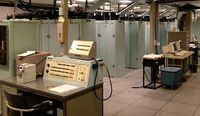|
The FERRANTI FM1600 CPU was designed for use in large centralised computer installations in major warships and was at the time when the brochure came out the most powerful in the Ferranti range. It is a 24-bit general purpose, real time central processor and is an integrated circuit version of the F1600 machine, which has been in service with the (UK) Royal Navy for many years, and uses the same range of proven software.
The FM1600B was used in many military equipment, especially on board of ships of the UK Royal Navy, other Navy's as well as in trainers, for instance in the Netherlands AA Tank Training System (Mech LUA).
FM1600B SYSTEM DESCRIPTION
Its very high speed (basic arithmetic functions of 3-address orders in 1.33 microseconds) and its many special features (including self checking) made it especially suitable for these applications, either singly or in multi-computer installations. The highly efficient Hermes F1600 3-address order code was used, as proved in earlier machines. The FM1600B was designed to work with core stores having cycle times down to l microseconds in amounts up to 262,000 words of 24 bits. Its own 1,024 word 80-bit micro-program store controlled basic computer operations as defined by the order code. The store could also provide extra order codes, input/output routines and extensive self-test facilities.
The CPU was engineered as a 3-shelf module containing 82 PECs. The front panel hinged for easy access and carries extensive monitoring facilities.
In systems where computers communicate directly with their peripherals a large amount of computer time is spent in organising peripheral data transfers. In Ferranti systems a Computer interrupt Equipment (CIE) was used to control the interface and organised and handled all transfers of data between the CPU and the peripheral control units (PCUs) in the appropriate order of priority. When necessary it also allowed the PCUs access to the core store with a minimum of computer control. Data transfers were effected by a 'handshake' technique which was part of the Standard Interface procedure common to all 1600 series systems and which became now standard for all Ministry of Defence computer systems. The use of a Standard Interface permitted all peripheral control units to be designed to a common doctrine, giving great flexibility in system design by avoiding the need to design special interface logic to permit each PCU to communicate with the CPU. The CIE also controlled the relative priority of PCU requests for data transfers to the CPU. In a multi-computer centralised system each computer's CIE was connected to each peripheral's PCU, so that any peripheral could be operated with any computer in a reduced working mode.
The CIE was engineered as a three shelf equipment and was fitted with PECs appropriate to the system input-output channel requirements. It was tested by using the micro-program facility built into the CPU. The CIE could accommodate up to 56 Standard Interface channels each PCU typically requiring one channel.
The FM1600B Central Processor Unit (CPU)
The FM1600B was a compact basic version of the FM 1600 developed to provide a suitable computer for use in smaller and more economical systems. Using the same instruction code as the FM1600, it could be employed with the same range of peripheral control units as it was engineered in the same for. The CPU had been reduced, by advanced design techniques, to only 19 electronic circuit packages occupying less than one standard shelf. This reduction in size (and cost) was not accompanied by a corresponding reduction in computing power. With a l microsecond cycle-time core store the speed of the FM 1600B was better than half that of the larger machine, and the difference could be further reduced by using 650 nanosec stores. Maximum store size is 65,536 words of 24 bits.
For smaller systems the CPU module could accommodate a store interface and a 1 microsec store of 4,096 words. A further 4,096 words could be housed in the associated CIE module. This combination provided an exceptionally compact system. For systems with greater store requirements the core store and interface were available as separate modules with a choice of speeds.
The CPU occupied one shelf of a standard cabinet. Control and monitoring facilities could be carried on the units front panel - or, alternatively, made available at a remote desk.
MEMORY
Ferranti 650 nsec core memory
In a real-time system virtually all the system programs and data must be available for immediate access when required. As a result it is normal to find that regenerative core storage forms the whole, or at least the greater part, of the store involved in such systems, and that additional stores, such as drums, discs or magnetic tape stores, play only a relatively minor part.
The cost of core storage in a typical real-time computer system is considerably greater than that of the computer itself. It is, therefore, particularly significant that efficient use should be made of this storage. The 24-bit word length chosen for 1600 series computers was found to be the most suitable for storing naval system data with the required precision. Similarly the 24-bit 3-address order structure developed for the 1600 series had proved exceptionally economical for program storage when compared with single-address systems.
The FM 1600 computer could be used in naval systems either with the Ferranti 1 microsecond cycle-time core-store or with the Plessey 1 microsecond (nominal) core store available in 16K or 32K word units. The FM1600B was used with Ferranti 1 microsecond core store or, more usually, with Ferranti 650 nsec core store.
The fast access 650 nsec core store provided a general purpose destructive readout and was built up from modules. Each module provided 16,384 words of 26 bits and also contained associated interface logic. A maximum of four modules could be assembled providing a total capacity of 65,536 words of 26 bits. Each module occupied a space 1/3 shelf wide by 3 shelves high, therefore 3 modules may be located side by side in two shelves of a standard cabinet, giving a 48K store. If the full 64K store was required the 4th module could be located alongside the first three in an adjacent cabinet. If this store was used for the FM1600B computer then the full power of the system could be realised. The cost (per word) of this store was less than for the 1 microsecond store as larger units were used.
Administrative history:
The Combined Tactical Trainer HMS Dryad [the navy traditionally names is shore bases as though they were ships] was a computer controlled training system. The system, known as the Action Speed Tactical Trainer [ASTT] gave training facilities for up to 22 groups of students in the solution of tactical problems involving vehicle movement, sensor selection and direction, electronic warfare, interpretation of data and weapon selection. The system used a series of computer controlled displays and control equipment to simulate combat and navigation problems for shipborne naval personnel. The CTT system was controlled by three F1600 Ferranti computers.
This exhibit was purchased from the MOD with the generous support of followers and friends on Twitter and Facebook. Read More >>>
Manufacturer: Ferranti
Date: 1965
Comment on This Page
Other Systems Related To Ferranti FM1600 B:
This exhibit has a reference ID of CH16840. Please quote this reference ID in any communication with the Centre for Computing History.
|
|
Click on the Image(s) For Detail
|



























